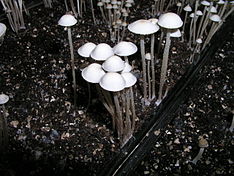- Panaeolus cambodginiensis
-
Panaeolus cambodginiensis 
Scientific classification Kingdom: Fungi Phylum: Basidiomycota Class: Hymenomycetes Order: Agaricales Family: Bolbitiaceae Genus: Panaeolus Species: P. cambodginiensis Binomial name Panaeolus cambodginiensis
Ola'h & R. HeimSynonyms Copelandia cambodginiensis (Ola'h & R. Heim) Singer & R.A. Weeks
Panaeolus cambodginiensis Mycological characteristics 
gills on hymenium 
cap is convex 
hymenium is adnexed 
stipe is bare 
spore print is black 
ecology is saprotrophic 
edibility: psychoactive Panaeolus cambodginiensis is a potent hallucinogenic mushroom which contains psilocybin. It was described in 1979 as Copelandia cambodginiensis.[1]
Contents
Description
The cap is less than 23 mm across, with a convex shape and an incurved margin when young, expanding to broadly convex. The cap surface is smooth, often cracking with irregular fissures. The gills are gray to black. The stem is 5 to 10 centimetres (2.0 to 3.9 in) tall, 4 mm thick, and slightly swollen at the base. The spores are blackish brown, shaped like lemons, smooth, measuring 11 x 8 µm. The entire mushroom quickly bruises blue where it is handled.
It can be differentiated from the similar Panaeolus cyanescens by microscopic characteristics.
Habitat and distribution
Panaeolus cambodginiensis is mushroom that grows on dung of water buffalo. It was first described from Cambodia and is widespread throughout the Asian subtropics and Hawaii.
See also
References
- ^ Weeks RA, Singer R, Hearns WL. (1979). "A new species of Copelandia". Lloydia 42 (5): 469–74.
- Stamets, Paul (1996). Psilocybin Mushrooms of the World. Berkeley: Ten Speed Press. ISBN 0-9610798-0-0.
External links
- Mushroom John - Panaeolus cambodginiensis
- Erowid - Panaeolus cambodginiensis
- A Worldwide Geographical Distribution of the Neurotropic Fungi
Categories:- Panaeolus
- Psychoactive fungi
- Psychedelic tryptamine carriers
- Fungi of Asia
Wikimedia Foundation. 2010.
